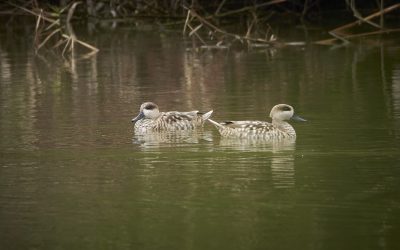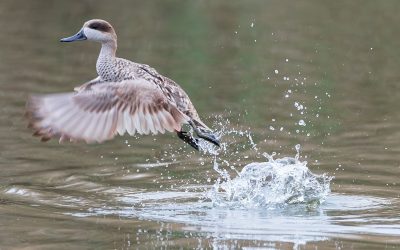The Brazo del Este is an old riverbed of the River Guadalquivir in Seville which, in its recent history, has undergone a series of transformations as a result of the cultivation of the land in its area of influence. These transformations, consisting of drainage and irrigation channels, retaining walls, roads, among other actions, caused the original water supply of the Brazo del Este, coming from the Guadalquivir river, to be completely interrupted and its course to be divided into several areas with totally autonomous water functioning.
The LIFE Cerceta Pardilla project has carried out habitat improvement actions with the aim of restoring the southern area of this space and recovering it for the marbled teal and many other bird species.
We talked about this with Alberto Sanabria Fernández, coordinator of the Plan for the Recovery and Conservation of Wetland Birds (PRCAH) of the Department of Sustainability and Environment of the Regional Government of Andalusia, a partner in the project.
1. First of all, it should be pointed out why the Brazo del Este Natural Site is so important for the marbled teal.
The marshes of the Guadalquivir have always been the bastion of the marbled teal in the Andalusian and national context, even more so when its populations have declined so drastically since the middle of the 20th century up to the present day.
The Brazo del Este Natural Site is one of the wetlands where the species currently breeds and is therefore considered critical in the Plan for the recovery and conservation of wetland birds in Andalusia. This makes it an extremely important place for its conservation, especially in times of drought when the Doñana marshes are dry, thanks to its capacity to artificially manage its flood levels.
2. What are the actions that the LIFE Cerceta Pardilla project has carried out in this natural area and what results are expected?
Environmental restoration work has been carried out in the area, some of which have already been completed and others are in progress. The aim is to increase the surface area of the habitat suitable for the species. And it has already borne fruit, because the project carried out has recorded the breeding of the species a few months after its completion.
Among the actions, I would highlight those carried out within the framework of the project in ‘El Reboso’, where restoration works were executed in an area of 24 hectares that were completed in the autumn of 2023 and where, as a symbol of success, a brown teal has already bred in the spring of 2024.
This gives us an idea of the importance of these restoration actions in key areas for the reproduction of the marbled teal, such as the Paraje Natural de Brazo del Este.
3. The success of these actions would not be possible without the collaboration of rice and livestock farmers who play a fundamental role in this project and for the conservation of the Brazo del Este. How has this been achieved?
The Brazo del Este is a space included in an agricultural matrix where several actors coexist. Adequate management of the area is not possible without considering the needs of the actors directly involved in the management of the territory. For this reason, for many years, work has been carried out to understand the situation of the environment in which the area is located, the needs of the groups involved and coordination formulas to establish systems of mutual collaboration.
In this sense, sustainable livestock farming favors the control of herbaceous biomass, i.e. grazing by domestic ungulates is used to facilitate the presence of open spaces that favor the generation of wet pastures and other open water areas, which are the main habitat of aquatic species.
On the other hand, the functioning of the rice field is of great importance for the maintenance of the water level in the Brazo del Este and, in turn, the rice field needs a complete flooding of the area for the regulation of the irrigation system to operate normally. In this case, such a mutually beneficial synergy is created that the collective itself actively participates in the water management of the wetland.
I would like to emphasise that the establishment of synergies and collaboration agreements with and between the agents of the territory, which is extremely essential in this Site, would not have been possible without the invaluable intervention of the technician of the Territorial Delegation of Sustainability and Environment of Seville and member of the Advisory Committee of LIFE Cerceta Pardilla, Antonio Rodríguez Sierra, who has been the link between all the actors involved in the management of the territory.
4.Thinking about the future, what role does land stewardship play in improving biodiversity in Brazo del Este and what expectations have been placed on this social figure of support for conservation.
This conservation figure is vital for the proper coordination of the functioning of the area, as it brings together the interests of different groups in a common goal. Thus, the initiative of an NGO (such as ANSE, SEO/BirdLife or WWF) can easily fit into the functioning of the site and create synergies between projects that might otherwise be more difficult to carry out.
The Andalusian Hunting Federation, acting as a land stewardship organization, can also play a key role. At present, work is already underway to bring hunters’ associations and the environmental administration closer together and to seek collaboration.
The constant and coordinated presence of all parties in the territory will generate a global vision of the problems and facilitate the localization of solutions that would be impossible or very difficult to implement if each party went it alone.
5. How do you visualize the Brazo del Este Site in the future when the LIFE Cerceta Pardilla project ends? Will actions continue to be promoted in this area?
The implementation of the measures planned in the Brazo del Este will improve the area as they will lead to the naturalization of important enclaves, especially those indicated as habitat for the marbled teal. Likewise, these measures will improve the control of water management, which will facilitate the appearance of new habitats suitable for the reproduction and breeding of marbled teal.
In the Brazo del Este, as a protected area of special importance for birds associated with wetlands, it is planned to continue implementing actions aimed at the naturalization of altered areas, both with the Department’s own projects and by facilitating access to NGOs and non-profit organizations particularly interested in the development of this type of project.




